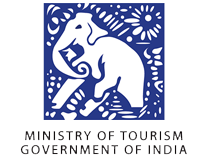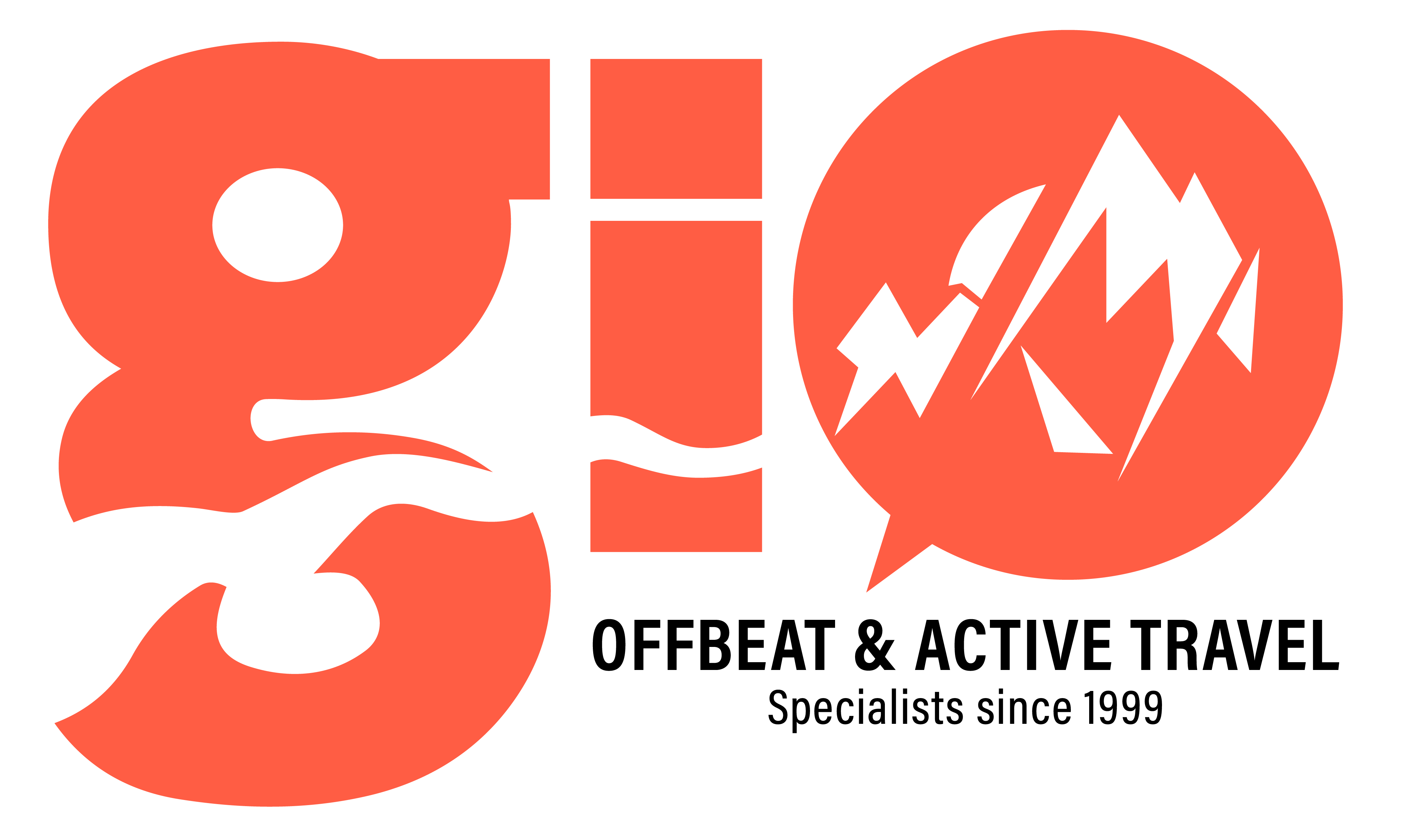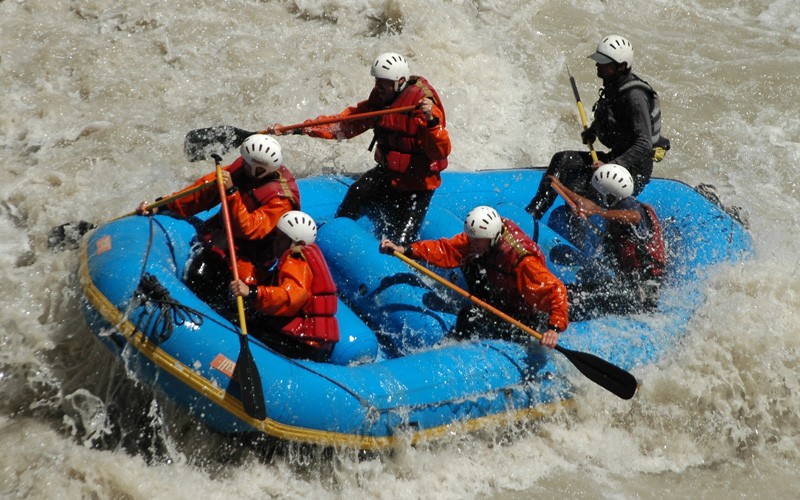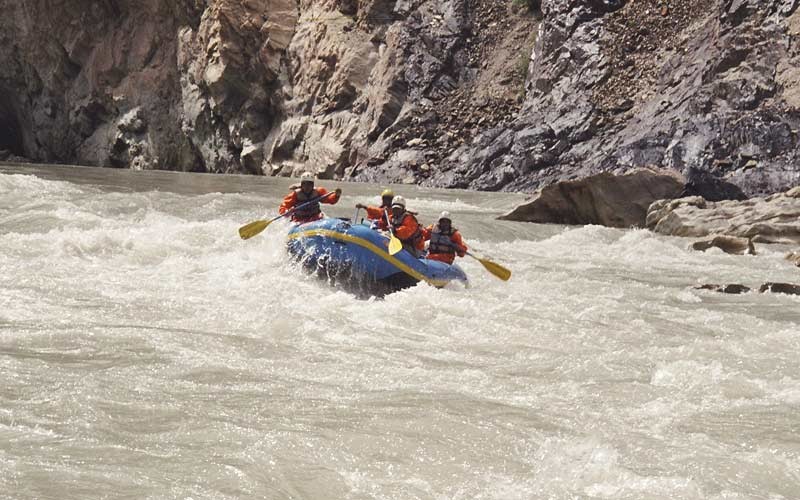- +91-7895979211, 7895979208
- LOGIN

RAFTING ON ZANSKAR
- Region - Uttarakhand
- Base Camp - Leh
- Duration 13 Days
- Altitute 3500m
- Stay Rooms/Tents
- Difficulty Vigorous
Detail itinenary
Arrival in Leh by the early morning flight. This is a spectacular flight with great views of the several glaciers and mountains of the Greater Himalayas. Check into your hotel and relax the whole day to acclimatize to the altitude. This is absolutely essential and even if one is feeling well, a day of complete rest is advised. Overnight at the hotel.
On this day you will go a sightseeing trip to some ancient monasteries in this area. Overnight in a hotel in Leh. Shey palace was built in 1645 by Deldan Namgyal as a summer residence for the kings of Ladakh. It is the oldest palace in Ladakh. Thiksey Gompa, close to Shey is about 17 kms from Leh. The monastery is considered to be one of the most beautiful in Ladakh and belongs to the Gelukspa order.Hemis, about 45 kms south of Leh it is one of the most famous and largest monastery in Ladakh. It belongs to the Drukpa order and was founded in the early 17th century. The setting is perfect with the monastery cradled in a lovely valley, surrounded by streams and fronted by long Mani walls. It was built in 1620 by the king-architect Singe Namgyal, a great patron of Buddhism. Hemis is the location for numerous religious festivals throughout the year.
Today you will drive through some amazing mountainscape to reach Kargil. The drive takes us over the Fotu La, the pass between the Indus and the Suru Valleys. En route you will halt at Lamayuru and visit the Monastery of the Red Sect, one of the oldest in the valley. Overnight at a hotel in Kargil.
Today you drive from Kargil to Rangdom. En route you will get a very close look at the twin Himalayan peaks of Nun & Kun. Also we will pass through the villages of Panikar and Prakachik. Towards the evening visit the ancient gompa at Rangdom. Overnight in tents.
A 6-hr drive will get you to Remala, the starting point of this grand journey. En route one crosses the Pensi La (14500 ft) and gets stunning views of the Zanskar range and the Durung Durung glacier (the glacier that feeds the Zanskar). Overnight in tents.
The raft trip starts on one of the tributaries of the Zanskar (Doda) with Class II rapids. The total rafting distance today will be 30 kms and will take about 5 hrs. The lone Karsha Gompa as it looks down the gorge will be crossed today. Those interested could trek up to its distant heights in the evening to attend the incantation service. Overnight in tents.
The Tsarapchu river joins the Doda at Zangla to form the Zanskar. The stretch today is about 25 km and takes one through Class II & III rapids. Today’s run will take about 4 hours. In the evening you have the option to hike up to the quaint village of Hanumil, seemingly untouched by the passage of time. Overnight in tents.
Today’s rafting section takes you through some great Class III rapids as the river narrows and enters the Zanskar gorges. From Hanumil we enter a spectacular canyon with towering rock walls on both sides. This is a breathtaking section of the river also you get to negotiate some exciting rapids on the way. Overnight in tents.
Today's 35 km stretch takes one through the heart of the Zanskar Gorge with heart pumping Class IV rapids interspersed between continuous stretches of Class III rapids. One of the highlights of the day is the pit stop for lunch at a huge waterfall at the confluence of the Zanskar and the Markha rivers. The sights and sounds of today's run on the river remains one of the highlights of this trip. Overnight in tents.
Today you give your arms a break and explore the Markha valley on foot. One can hike up to the villages of Kaya & Skiu from the campsite. Also you have the wonderful option of just lazing at the camp and soaking in the spectacular beauty of the Zanskar & Markha valleys. Overnight in tents.
Today you will run the river for about 40 kms taking about 3-4 hrs. En route you will negotiate the Chilling rapid. Today’s run will have Class III rapids with one Class IV rapid. It’s an interesting run as you will come out of the Zanskar gorges and meet the mighty Indus river at Nimo. You end your river trip at the confluence. We will set up camp here for the night and have a celebratory party under the stars in the evening. Overnight in tents.
After breakfast you will drive for about an hour to reach Leh. Rest of the day at leisure to explore the sights and markets of Leh. Overnight in a hotel
Take the morning flight for your onward destination.
SKETCH ITINERARY
The Zanskar valley in Ladakh is one of the most beautiful valleys in the region with ever changing landscape and close encounters with natures beauties such as snow peaks, glaciers, long unwinding cold desert, gorges, etc. Through this valley cuts the Zanskar river and its tributaries. The river in addition to being an exciting way to explore the region also provides the white water enthusiast with excellent rapids and an unforgettable rafting trip. There are rapids of all classes and beautiful camping sports to unwind after a day on the river. The drive to the beginning of the rafting trip is an experience in itself and coupled with the exciting rafting trip, this trip is sure to be one of the most memorable experiences of your life.
Detail itinenary
Arrival in Leh by the early morning flight. This is a spectacular flight with great views of the several glaciers and mountains of the Greater Himalayas. Check into your hotel and relax the whole day to acclimatize to the altitude. This is absolutely essential and even if one is feeling well, a day of complete rest is advised. Overnight at the hotel.
On this day you will go a sightseeing trip to some ancient monasteries in this area. Overnight in a hotel in Leh. Shey palace was built in 1645 by Deldan Namgyal as a summer residence for the kings of Ladakh. It is the oldest palace in Ladakh. Thiksey Gompa, close to Shey is about 17 kms from Leh. The monastery is considered to be one of the most beautiful in Ladakh and belongs to the Gelukspa order.Hemis, about 45 kms south of Leh it is one of the most famous and largest monastery in Ladakh. It belongs to the Drukpa order and was founded in the early 17th century. The setting is perfect with the monastery cradled in a lovely valley, surrounded by streams and fronted by long Mani walls. It was built in 1620 by the king-architect Singe Namgyal, a great patron of Buddhism. Hemis is the location for numerous religious festivals throughout the year.
Today you will drive through some amazing mountainscape to reach Kargil. The drive takes us over the Fotu La, the pass between the Indus and the Suru Valleys. En route you will halt at Lamayuru and visit the Monastery of the Red Sect, one of the oldest in the valley. Overnight at a hotel in Kargil.
Today you drive from Kargil to Rangdom. En route you will get a very close look at the twin Himalayan peaks of Nun & Kun. Also we will pass through the villages of Panikar and Prakachik. Towards the evening visit the ancient gompa at Rangdom. Overnight in tents.
A 6-hr drive will get you to Remala, the starting point of this grand journey. En route one crosses the Pensi La (14500 ft) and gets stunning views of the Zanskar range and the Durung Durung glacier (the glacier that feeds the Zanskar). Overnight in tents.
The raft trip starts on one of the tributaries of the Zanskar (Doda) with Class II rapids. The total rafting distance today will be 30 kms and will take about 5 hrs. The lone Karsha Gompa as it looks down the gorge will be crossed today. Those interested could trek up to its distant heights in the evening to attend the incantation service. Overnight in tents.
The Tsarapchu river joins the Doda at Zangla to form the Zanskar. The stretch today is about 25 km and takes one through Class II & III rapids. Today’s run will take about 4 hours. In the evening you have the option to hike up to the quaint village of Hanumil, seemingly untouched by the passage of time. Overnight in tents.
Today’s rafting section takes you through some great Class III rapids as the river narrows and enters the Zanskar gorges. From Hanumil we enter a spectacular canyon with towering rock walls on both sides. This is a breathtaking section of the river also you get to negotiate some exciting rapids on the way. Overnight in tents.
Today's 35 km stretch takes one through the heart of the Zanskar Gorge with heart pumping Class IV rapids interspersed between continuous stretches of Class III rapids. One of the highlights of the day is the pit stop for lunch at a huge waterfall at the confluence of the Zanskar and the Markha rivers. The sights and sounds of today's run on the river remains one of the highlights of this trip. Overnight in tents.
Today you give your arms a break and explore the Markha valley on foot. One can hike up to the villages of Kaya & Skiu from the campsite. Also you have the wonderful option of just lazing at the camp and soaking in the spectacular beauty of the Zanskar & Markha valleys. Overnight in tents.
Today you will run the river for about 40 kms taking about 3-4 hrs. En route you will negotiate the Chilling rapid. Today’s run will have Class III rapids with one Class IV rapid. It’s an interesting run as you will come out of the Zanskar gorges and meet the mighty Indus river at Nimo. You end your river trip at the confluence. We will set up camp here for the night and have a celebratory party under the stars in the evening. Overnight in tents.
After breakfast you will drive for about an hour to reach Leh. Rest of the day at leisure to explore the sights and markets of Leh. Overnight in a hotel
Take the morning flight for your onward destination.
Price Info
- Transport from and back to Leh including pickup & drop to Leh airport on Day 1 & 13.
- Accommodation:
- Leh / Kargil - In a hotel in Standard rooms on twin-sharing basis
- On the river – In comfortable all-weather trekking tents. During the camping, you would be provided with comfortable sleeping bags and camping mattresses.
- Food: Veg meals. All meals beginning with lunch on Day 1 to breakfast on Day 13. We would provide non-veg meals wherever possible but keeping with the nature of the trip, vegetarian cuisine would be the primary choice. Lunch on rafting days would be packed for having enroute and all other meals would be freshly prepared by our kitchen team which would be travelling along with the expedition.
- Body suits and dry tops for the rafting to keep warm while on the river
- Experienced instructors, safety kayakers & state-of-the-art equipment to ensure maximum safety
- Bonfire in the nights (wherever possible)
- Service Tax
- Any airfare
- Liquor, soft drinks, bottled water, beverages, etc.
- Personal expenses like tips, telephone calls, etc.
- Any services / meals not mentioned above
- Any costs rising due to delays, bad weather, landslides, etc.
- Insurance
Departure Dates
Departure Dates
Reviews
PAYMENT TERMS & CONDITIONS
- All payments for the trips, transfers, porterage, etc. should be made in full before the trip starts.
- Cancellation Policy: In the event that you need to cancel your booking due to any avoidable or unavoidable circumstances:
- We must be notified of the same in writing. Cancellation charges will be effective from the date we receive the request in writing. Any cancellation sent on a Sunday or any National Holiday(s), will be considered on the next official working day.
- Payment for this trip will not be adjusted towards any future trip(s)
- In the event of any cancellation(s) after trip commencement, there will be no refunds and any costs incurred due to this cancellation will be borne by you.
- Irrespective of when a trip is booked, the above condition will hold true
- Cancellation charges will be as follows
- >45 Days: Full refund (after deducting any expenses that have been incurred for hotel bookings, transport, etc.)
- 30-45 Days: 75% of trip cost will be refunded (after deducting any expenses that have been incurred for hotel bookings, transport, etc.)
- 15-30 Days: 50% of trip cost will be refunded (after deducting any expenses that have been incurred for hotel bookings, transport, etc.)
- <15 Days: No refund
VITAL INFORMATION
WEATHER DETAILS
This snow trek is organized between Dec & mid-March when the region has had good snowfall. Contrary to the popular belief winters is a good time to be in the mountains if one is equipped properly. Most locals inhabiting higher reaches of the mountains don’t mind the problems associated with snowfall and seem to have a good time during these months. Also there are lots of local festivals in these months. In these months weather is generally clear most of the days. Day time is normally pleasantly warm with one getting to enjoy sitting out in the sun. Temperature would be around 12-17 °C. Evenings are quite cold and one would need to be inside a tent/room or sitting outside next to fire with proper winter clothes. The evening temperatures will be around – 3 to 5 °C. Nights can be very cold with temperatures in the range of – 8 to 0 °C.
Please keep in mind that the above information is not exact and does not account for sudden changes. Whatever the temperatures and conditions rest assured we will be prepared to handle it with ease as we use equipment of very high specifications.
LIST OF ESSENTIALS
It is very important for this adventure trip that you need to be equipped properly and with a bit of back up. Mountain/adventure travel requires one to be adequately equipped with the right kind of personal gear. Since one is travelling in the wilderness there will be hardly any opportunity to buy anything once you hit the trail so we urge you to carefully pack everything into your bags.
- T-shirts (Full) – 2/3
- Warm shirt/light micro fleece pullover/full sleeve T shirt
- Trekking Pants (water resistant/repellent & having inside lining for extra warmth) - 2
- Windproof/water resistant outer shell (jacket) of good quality (no flimsy wind cheaters please!) with a proper hood
- Down jacket with min 600 fill power rating
- Thick Fleece / Full-sleeve Woollen sweater
- Thermal inner wear (upper & lower)
- Woollen cap (Balaclava)
- Inner fleece gloves
- Outer water proof gloves
- Thick woollen socks & regular socks (4 – 5 pairs)
- Scarf/muffler (optional)
- Comfortable waterproof (Goretex) Trekking/Hiking shoes (shoes with a thick sole and high ankles are recommended)
- Camp shoes (these can be easy to slip in sneakers/sport shoes)
- Gaiters
- Raincoat / Poncho
- Small light weight towel
- Insulated water bottle & hydration pack (optional)
- Cap / floppy hat to keep the strong sun away from your face
- Sun glasses with UV protection and ability to cut the glare (imp when traversing through snow)
- Sturdy walking stick / Trekking pole
- Sunscreen Lotion
- Lip Balm
- Torch / Flashlight (with extra batteries)
- Medicines, if requiring any specific medication
- Personal toiletries
- Book, if you like reading
- Day pack/small bag which you will carry on your back every day and keep your essentials in it
- Carry rain cover for your bags
- Keep a few poly bags or waterproof bags in your bag in which if required you can put your belongings in case of heavy rain
- Camera if you like (with fully charged batteries)
- …LOADS OF ENTHUSIASM!! AND A PLEDGE TO LEAVE NO TRACE
Carry your stuff in a duffel bag, soft shoulder bag or a rucksack. Avoid suitcases, trolleys or any other hard luggage. As you will be walking long distances carrying a rucksack, avoid bringing unnecessary items on the trek. Please avoid carrying expensive watches, jewellery and electronic items on the trek.
NOTE: In case you are planning to put your bag on a mule or taking a porter please get a duffel bag or rucksack and keep it in mind that there is a possibility that the bag at times might brush against a rock or a tree and get slightly damaged so don't get very expensive bags. Also in case of damage we shall not be held accountable.
TRANSPORT OPTIONS (DELHI – DEHRADUN – DELHI)
For travel to Dehradun/Haridwar/Haridwar, one can choose between air, rail & road. For air travel, the closest airport is the Jolly Grant Airport (Dehradun) and is well connected to Delhi and other parts of the country by Air India, Jet Airways, GoAir & Spice Jet. Train travel is highly recommended with enough options being there. For train details, you could log on to www.indianrail.gov.in and for online railway ticket bookings you could log on to www.irctc.co.in.
There are frequent Public Transport buses including Volvos available from Delhi to Dehradun that cost about Rs. 300 - 800 per person. These buses depart from Delhi ISBT every 30 mins to 1 hr or so and take about 4/5 hrs to cover the distance. The same is also applicable on the return journey. A private vehicle could also be arranged for if you require the same.
OUR TREKKING CODE
We are mountain lovers and have pledged to bring no harm to them in our pursuit of running organised wilderness travel in the Himalayas and seek your assistance too in this regard. We are more than convinced that one can have more fun on a trip if we go about it in a way that no harm is caused to the ecology. In this regard we have a set of guidelines that we adhere to based on the tenets of 'Leave No Trace' & 'Tread Light' policies. These guidelines are very simple and emphasise on travelling in small groups, better planning, understanding impact of camping, proper waste disposal, respecting local cultures, sensitivity towards wildlife and so on. We have a complete section on our trekking code in the 'GIO trekking Manual'. This manual will be couriered to you once you confirm a trip with us.
ACCLIMATISATION & HIGH ALTITUDE SICKNESS
This is one of the most important aspects of traveling in the high Himalayas and cannot be ignored or set aside. Acclimatization basically means our body adjusting to lower levels of oxygen (rarefied air) & reduced air pressure as me move up. In case one does not acclimatize properly there are chances of the person facing extreme discomfort and this can be fatal in extreme cases. While there is no set route to getting properly acclimatized there are general precautions and steps that one can take to initiate good acclimatization. Our trekking guides will assist you with these steps and also once you book a trip with us the 'GIO Trekking Manual' which will cover this aspect extensively will be couriered to you. This is sure to help you enjoy the trek in very good shape.
SELECTING THE RIGHT TREK & TRAINING FOR IT
Most important thing is to select the right trek keeping in mind your experience or inexperience, health, objectives & ability. Our senior team people can assist you with this, so when contacting us do mention if you need guidance on this front also refer to our trek grading system mentioned below. Once the right trek is selected comes your preparation. Once you have booked a trip with us we will courier the 'GIO Trekking Manual' to you which will have a complete practice drill explained in detail.
TREK GRADING SYSTEM
We have broadly classified our treks as below:
Easy: These treks are 3 to 5 days long and involve walking for about 3/4 hrs daily. The trail on such treks is well defined but not always flat. These are great for families and first-timers
Moderate: On these treks, one is not required to trek for more than 5/6 hrs a day. Also the terrain is not too difficult. These treks are normally a week or so long. For these treks, prior trekking experience is not necessary. Very rarely on these treks would one camp at altitudes higher than 3800m. These treks are great for first-timers or for veterans wanting to go on a trail which is relatively less demanding
Moderate+: These are moderate treks with mostly one difficult day. These trails are fine for fit beginners also.
Vigorous: On these treks one can be required to trek continuously for more than a week through remote areas and at times trekking for more than 7 hrs a day. On most of these treks one has to cross passes or areas which are snow-covered and involve camping at an altitude of more than 4000m. Fit people with some kind of hiking experience & a spirit of adventure can contemplate going on these trails.
Strenuous: These treks apart from having continuous trekking stretches are at places technical and might require assistance from trip leader/guide and other staff people. All these treks have rest days in between. Also, all of them involve crossing passes or areas having an altitude of more than 4500m. First-timers are discouraged from walking such routes.
Expedition Style: These involve long walks at high altitudes at times around 6000m. Camping can also be well over the snow line and on glaciers at times. Safety ropes, ice axes, and crampons might be required on these treks. These treks are not technically very difficult but are considerably challenging. Previous vigorous/strenuous trekking experience is required.
DISCLAIMER
Great Indian Outdoors (P) Ltd. takes utmost care to ensure the safety of its clients. However, in the case of any unforeseen mishaps, Great Indian Outdoors (P) Ltd. will not be liable for any injuries caused or for loss of life. All disputes rising due to the above are subject to the jurisdiction of the courts in New Delhi/Delhi only. All participants would be required to sign an Indemnity Form before the start of the program, without which they would not be allowed to take part in the trip/program/activities.
Recognised by Ministry of Tourism, Government of India as an Approved Adventure Tour Operator



Contact Us
 GIO Adventures Pvt. Ltd
GIO Adventures Pvt. LtdDehradun - Uttarakhand
- +91-7895979211
- info@gio.in


